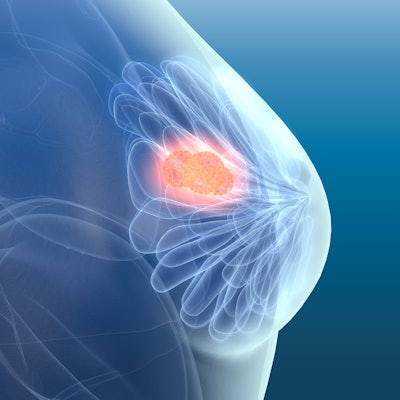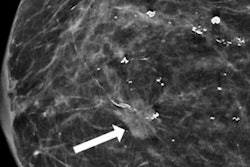
Women diagnosed with ductal carcinoma in situ (DCIS) during screening are at higher risk of developing breast cancer and of death from breast cancer, according to research involving over 35,000 women published on 27 May by the BMJ. One expert has called the study "revolutionary."
The risks were more than double those of the general population, even for women diagnosed with low or intermediate grade DCIS, and lasted until at least 20 years after diagnosis, noted lead author Gurdeep Mannu, PhD, clinical research fellow in cancer surgery at the University of Oxford, U.K., and colleagues.
"This study provides evidence of the long-term nature of the risk of invasive disease after a diagnosis of DCIS, and these findings will contribute towards future guidance for surveillance of women," Mannu told AuntMinnieEurope.com in an email. "Women diagnosed with DCIS generally have a very good prognosis, but they do still have an increased risk of developing invasive breast cancer. So it is important for them to continue to attend for breast screening."
 Gurdeep Mannu, PhD, from Oxford University.
Gurdeep Mannu, PhD, from Oxford University.The authors evaluated data from 35,024 women in England diagnosed as having DCIS by the National Health Service (NHS) Breast Screening Programme from its start in 1988 until March 2014. They compared rates of invasive breast cancer and of death from breast cancer with the corresponding national rates for women of the same age in the same calendar year.
Mannu and colleagues found that by December 2014, 2,076 women had developed invasive breast cancer -- an incidence rate of 8.82 per 1,000 per year, and more than double the number expected from national rates. In the same group of women, 310 died from breast cancer, a death rate of 1.26 per 1,000 per year and 70% more than expected from national rates.
Additionally, the researchers found that women who had more intensive treatment, such as a mastectomy, had a lower long-term risk of invasive breast cancer than those who had breast-conserving surgery, even when radiotherapy was given. Larger surgical margin widths were also associated with a lower rate of invasive breast cancer, as was endocrine treatment for women with estrogen receptor-positive disease.
Currently, surveillance of women after a diagnosis of DCIS tends to focus only on the first few years. In the UK, for example, most women are recalled for yearly surveillance mammograms for five years, after which further follow-up is once every three years via the national screening program up to age 70. This approach might well change, the authors believe.
"Revolutionary" article
Budapest radiologist Dr. Gábor Forrai, PhD, past president of the European Society of Breast Imaging (EUSOBI), thinks the new BMJ study is highly significant.
 Dr. Gábor Forrai, PhD, past president of the EUSOBI.
Dr. Gábor Forrai, PhD, past president of the EUSOBI.DCIS is frequently considered -- in the eyes of the public and among specialists as well -- as being a harmless precancerous disease, which, if cured primarily by surgery, is not causing any further danger to the patient, though of course regular follow-up is recommended in these cases, Forrai told AuntMinnieEurope.com in an email.
An important development was the 2012 study in the British Journal of Cancer by Dr. Matthew Wallis from Cambridge, U.K., which showed that a 15-year follow-up of DCIS cases showed a dramatically different recurrence rate (double) compared with the usual follow-up period of five years.
"We have known already that DCIS could not be evaluated according to the usual follow-up numbers, but that's why the present article is even more revolutionary: It emphasizes that DCIS have to be taken more seriously, as not only the recurrence but also the death rate is increased after a DCIS is detected," he noted.
For radiologists and other specialists (including surgeons, oncologists, and pathologists), Forrai reckons this observation could mean the following:
- Pathological and radiological free margins have to be analyzed and documented even more precisely.
- A larger free margin as a rule has to be (re)introduced for DCIS cases.
- DCIS cases resected with suboptimal margins should be treated more aggressively (by resection/radiotherapy) than it is the current norm.
- Preoperative evaluation of the real extent of the disease is even more important than previously thought. This means more preoperative imaging exams may be necessary, especially breast MRI, which is known as the best method for evaluating the extent of DCIS.
"The problem of noncalcified DCIS cases could be probably much more important, as these are not visible/not detectable at all on mammography, so MRI in this indication is the only modality which shows the DCIS disease itself and its extent," Forrai pointed out.
What does the future hold?
Looking ahead, Mannu concedes that the COVID-19 pandemic is likely to delay future progress temporarily, but he is convinced that further studies are needed to build on these findings, in particular to try to work out which type of DCIS is most closely linked to the development of invasive breast cancer. This may have implications for follow-up and the frequency of imaging.
"We are planning to examine the extent of margins (obtained during surgery for DCIS) and the subsequent risk of invasive breast cancer in more detail because the optimal margin distance in DCIS is an area of particular interest to surgeons and patients. We also plan to examine the rate of invasive breast cancer in women diagnosed with DCIS outside of the screening programme," he concluded.
Mannu's area of special interest in the epidemiology of DCIS, and he is principal investigator of the Non-Invasive Breast Cancer in England (NINBE) study. He has a particular interest in the long-term outcomes after treatment for noninvasive breast disease. His research comprises epidemiological analyses of population-level data in relation to women with noninvasive and invasive breast cancer.



















